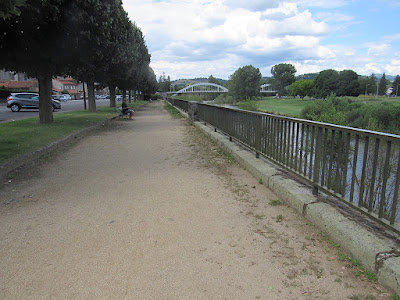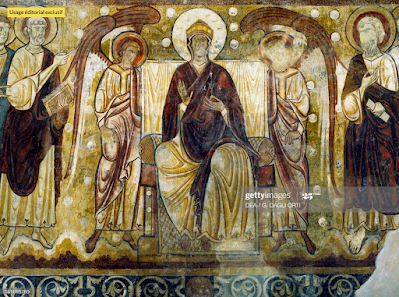It was just a drive through the countryside that led us to Langeac and the area surrounding it one fine day in June. The French countryside is so beautiful, just a drive through it brings much pleasure and satisfaction. We came upon wheat fields, the Allier River, a goat farm, a former Benedictine priory, and an old windmill.
Langeac is just 40 minutes west of Le Puy.
Allier River
The Allier River flows 262 miles through central France from its source in the Massif Central just east of the city of Mende. It is a left tributary of the Loire flowing north and joining the Loire west of the city of Nevers.
The 16th and 17th centuries were very prosperous times for Langeac, a small market town full of artisans. Following the Napoleonic wars (1803-15), artisans and merchants also benefited. However, exploitation of wood, stone quarries, coal mines, antimony, lead, and silver led to several devastating river floods. In the 1860s the railroads superceded river transport and the floods subsided. Townsmen then learned how to repair and maintain locomotives.
Today, the town regards the Allier River as a place of beauty and respite. It has built a riverfront walkway and park to take advantage of this picturesque view.
 Even the simple wheat
fields of Langeac are beautiful as they are framed by a gorgeous
landscape surrounded by mountains. Eluiza found some yellow flowers on
the edge of the wheat field that she couldn't resist picking. The video below captures the waves of grain.
Even the simple wheat
fields of Langeac are beautiful as they are framed by a gorgeous
landscape surrounded by mountains. Eluiza found some yellow flowers on
the edge of the wheat field that she couldn't resist picking. The video below captures the waves of grain.
 We returned to this area in October and discovered the small town of Lavoûte-Chilhac. just 8 miles northwest of Langeac. Before we arrived there, we spotted a sheep farm where the herd was munching on grass. I clapped my hands and they all moved toward our car. It was quite a sight to see a swarm of sheep all moving together toward us. Unfortunately, I didn't take a video camera to record them, but did manage to take a photo of them near the fence.
We returned to this area in October and discovered the small town of Lavoûte-Chilhac. just 8 miles northwest of Langeac. Before we arrived there, we spotted a sheep farm where the herd was munching on grass. I clapped my hands and they all moved toward our car. It was quite a sight to see a swarm of sheep all moving together toward us. Unfortunately, I didn't take a video camera to record them, but did manage to take a photo of them near the fence.
Lavoûte-Chilhac

Lavoûte-Chilhac goes back to ancient times, but on September 14, 1025, Odilon de Cluny, then 5th Abbot of Cluny, founded the priory of Sainte Croix The Volte. The fashion for priories at the time was an emphasis on modesty and austerity. In 1406, the priory was much run down so restoration in mid-century replaced the early Romanesque church. Between 1778-90 a new wing was being constructed to make a horseshoe shape of the priory, however, that work was cut short by the French Revolution. The monks soon afterward abandoned the priory.
Lavoûte-Chilhac is actually made up of two neighborhoods separated by the Alliers River and connected by an old stone bridge. On the left bank are a series of riverside houses with high façades to guard
against flooding (see photo above). On the right bank is the old Cluniac priory (see below). Behind this large structure is Sainte-Croix Church noted with the bell tower that is made from volcanic lava rock.
The priory complex has some interesting features. The front entrance is a horseshoe shape with a tunnel that leads to the church.

The rose window on the facade is divided into 12 ray lobes.
This 12th century Romanesque polychrome crucifix depicts Jesus' eyes open. Before the 13th century, artists were reluctant to represent a suffering Christ. 

The altarpiece was installed in 1713.
The choir stalls that wrap around the wall behind the altar are made of walnut and hand-carved.
The Signs of the Times
 As we cruised around the village, we noticed a small sign on the left bank that pointed to an historic windmill. After a long winding drive outside the village and into the countryside, we found it, albeit with a more familiar design. In the distance were modern windmills that generate power from the wind. This region of France is full of them thanks to the mighty winds of the Massif Central! The old windmills were used only to grind grain.
As we cruised around the village, we noticed a small sign on the left bank that pointed to an historic windmill. After a long winding drive outside the village and into the countryside, we found it, albeit with a more familiar design. In the distance were modern windmills that generate power from the wind. This region of France is full of them thanks to the mighty winds of the Massif Central! The old windmills were used only to grind grain.
Besides its historical heritage, Lavoûte-Chilhac today is a
popular place for outdoor activities
like canoeing, fishing and hunting. Due to the coronavirus, it was
rather quiet except for a group of people playing pétanque, a popular
game similar to bocci ball in Italy.
















































